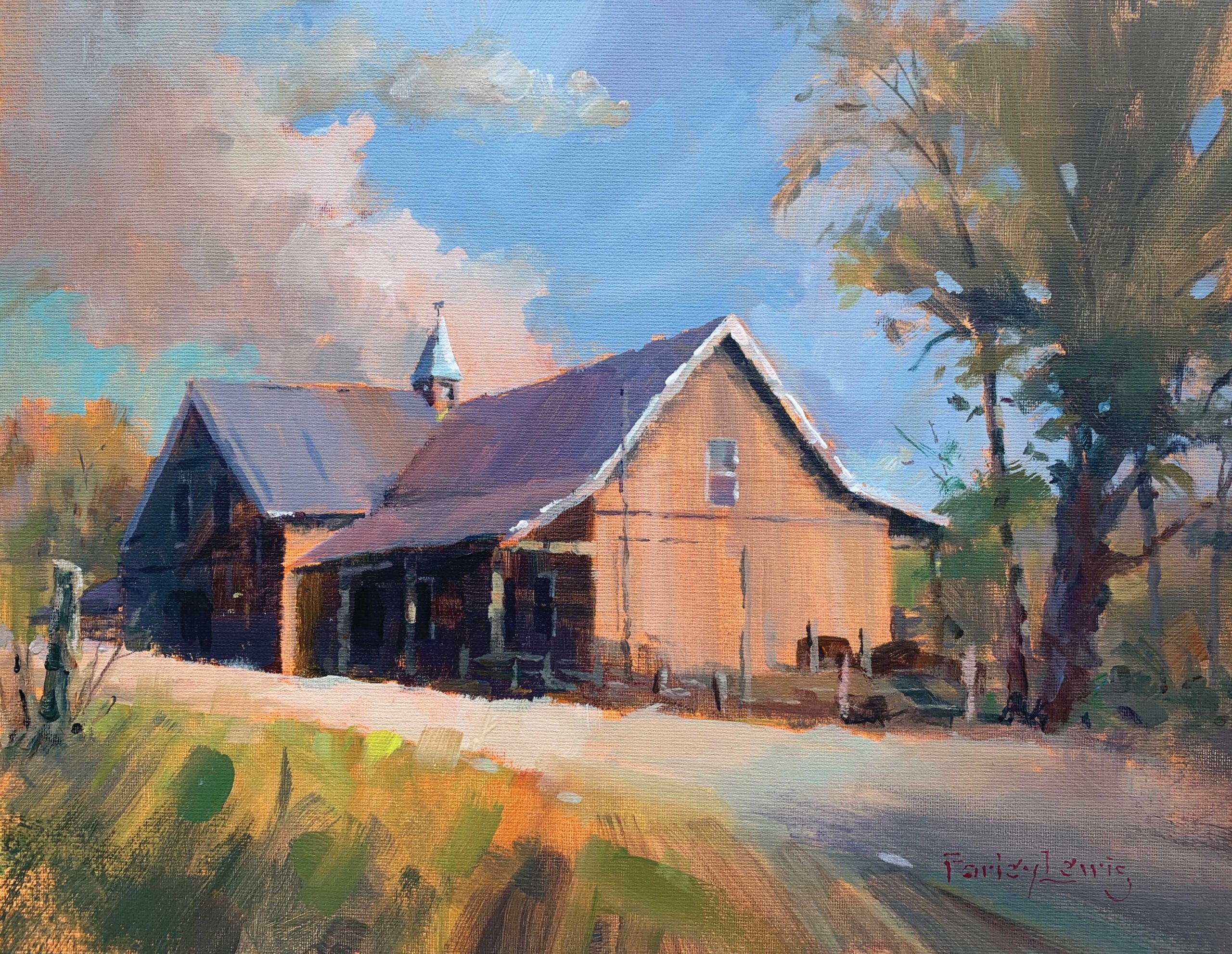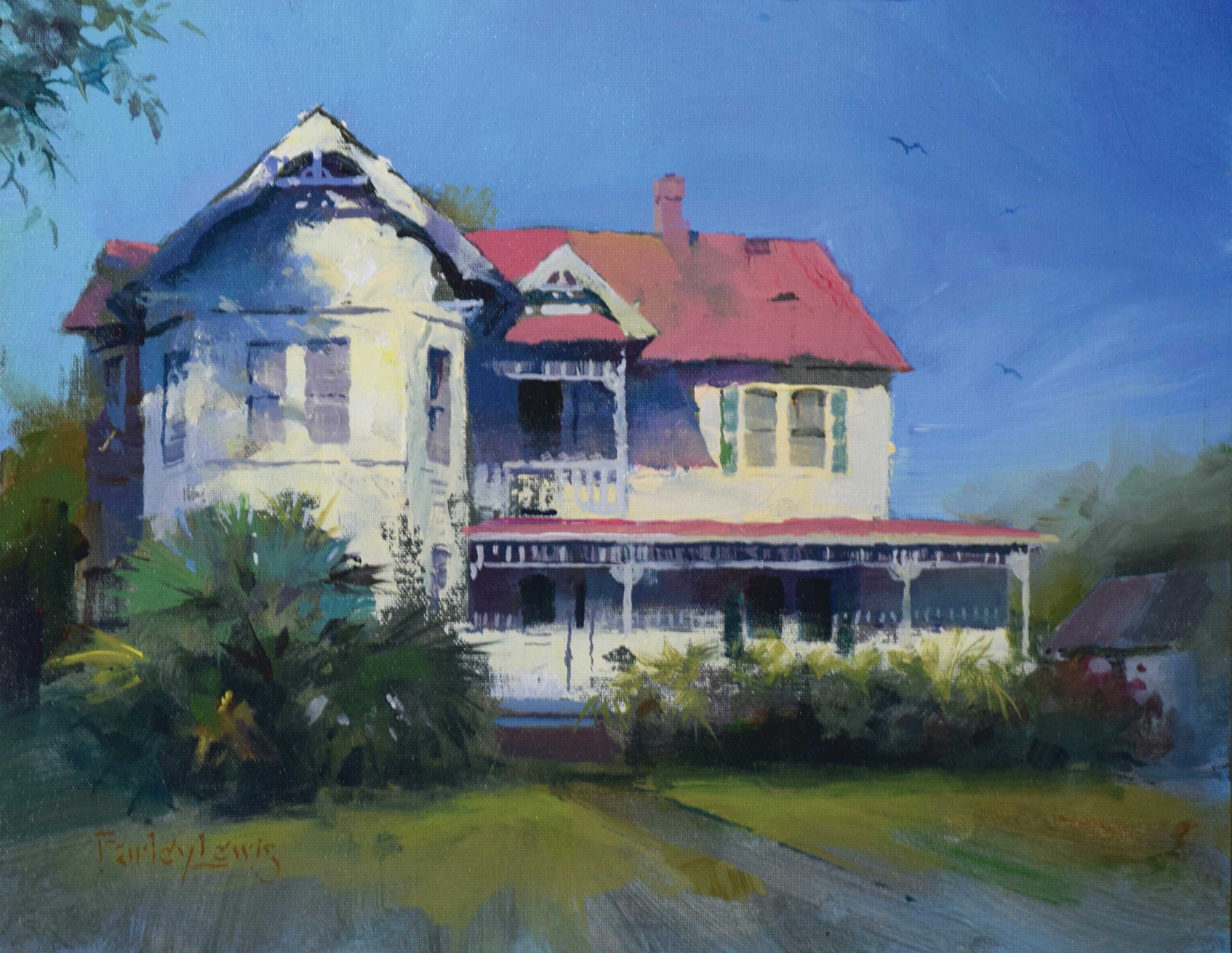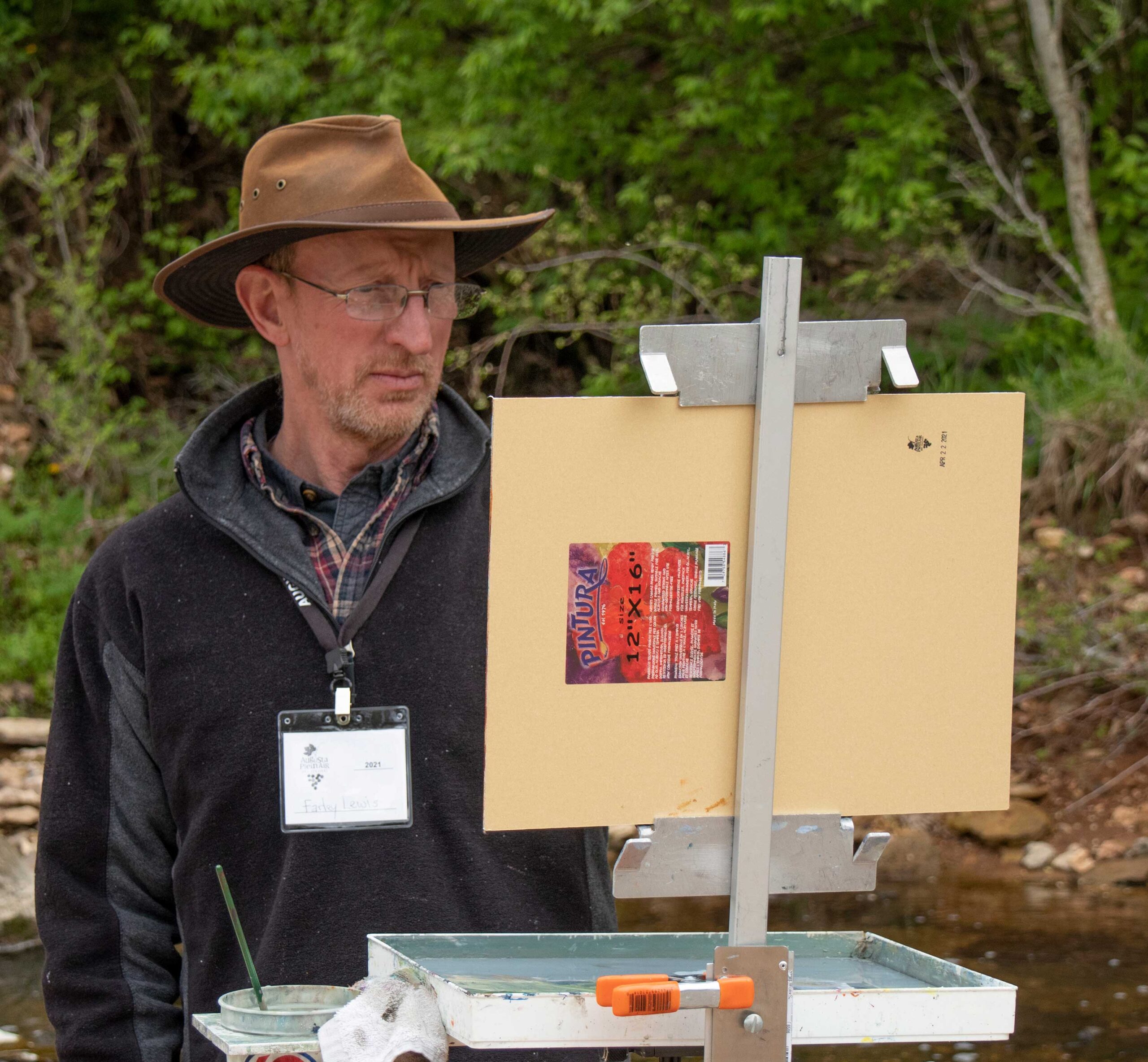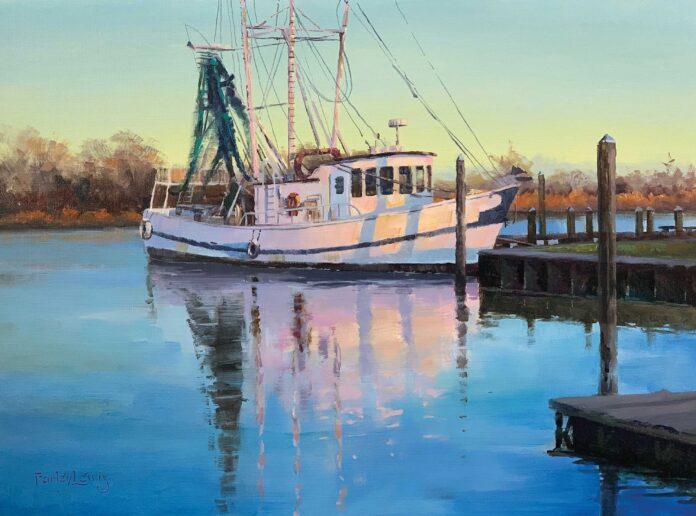This Missouri acrylic plein air painter strives to depict beauty with a mix of simplicity and just enough detail. Farley Lewis has traveled the globe, completing murals in South Africa, Israel, Mexico, and Canada, but he makes his home in Springfield, Missouri.
Acrylic Plein Air Painting: Risk Leads to Discovery
At some point, an artist’s skill level can pose a threat of sorts to the potential of a painting. The easier it is for a painter to execute a scene, the more consciously he or she must push forward to make the best painting possible. Farley Lewis is a veteran painter and art teacher, and he takes steps early on to make sure he challenges himself.
“I start paintings in different ways, mixing it up with a variety of techniques to tone the surface, in part because I know myself,” he says. “I could rely on formula to minimize risk and try to prevent failure. I don’t want to do that. I would rather live with a little more risk to get a little more discovery. You don’t become a good artist by playing it safe.” Lewis asserts that play is the mother of creativity.
“I like to try new things,” he says. “Sometimes I do my whole block-in with a rag. I don’t get a careful drawing, but I get the major shapes. I can define lines further down the road. Occasionally I will get an edge right with the rag, but if I don’t, it’s not a big deal. The abstract arrangement of shapes and colors is the foundation for a landscape painting, so a quick, free, playful beginning should show through to the very end of the piece.”

A Solid Drawing Foundation
Lewis can be very loose in his painting if he wishes, in part because his drawing skills are beyond reproach. “I used to teach drawing at the high school level and I had a ton of drawing in college, and that gave me a good foundation,” says the artist. “Drawing is not like learning to ride a bike. You don’t learn it once and then it’s always easy to do. It’s more like ballet or cross-country running; it’s something you have to stay after.”
Lewis continues, “As many houses and barns and bridges as I paint, drawing is critical for my work. No amount of flashy color or interesting brushwork is going to make up for something that is poorly drawn. I take my time and draw it carefully. Even as I paint, I’m still drawing, in the sense that I’m correcting the angle of the roofline, say, when I’m painting the sky.”
Solid drawing does not necessarily mean a tightly rendered painting. Look at Lewis’s painting “Gingerbread” (below) to see how he draws accurately yet keeps the subject matter a bit loose and painterly. He says he particularly enjoys the contrast of nature against architecture and other manufactured elements. But if a barn is drawn wrong, the painting fails.

In “Gingerbread,” the roofline on the left does not have a complete black line where the eaves create dark shadows, but the shadow is stated just enough in a broken manner that it’s convincing. The foreground of the piece is painted more to create a sense of perspective than to describe the grass and ground.
Complexity is not his goal. “When I’m scouting an area to paint, I look for simple shapes,” he says. “Beauty is simple. The scene may be very complex, but if I can see how to organize the pieces into simple value masses, I know I have a shot at making a good painting out of it. I like to find beauty in the ordinary — the way the sun catches the corner of a house, the arrangement of outbuildings scattered around a farm, a lone cedar in a field of harvested corn.”

A Selective Focus
His drive to simplify in a strategic way stems in part from the impossibility of incorporating everything in a single painting, assuming one is not a photorealist painter. “You always see more than you paint,” says Lewis. “There’s always more detail than you can put in the painting. When I study a scene, I’m looking for the main and the plain. I’m ignoring individual leaves to see the overall shape of the tree. In a stream, I ignore the little ripples to observe and paint the overall color transitions that are happening in the water.”
One way to suggest detail without painting it is to embrace the texture that saturates the landscape. “I like experimenting with texture — smearing things with a rag, splattering paint with a toothbrush,” says the artist. “Nature is loaded with texture, more than you could ever capture in a painting. So instead of loading the painting with tons of individually painted rocks and leaves, why not create texture that reads like detail?”
Besides, the details are rarely what motivate a painter to capture a scene, nor is the symbolic content of the subject matter. “If you start your painting without a clear ‘why’ — the visual element that first caught your eye — you have virtually no chance of capturing it,” he asserts. “If you’re painting a bridge because you like bridges, that’s a good start, but it’s not enough. The answer you need is not a sentimental answer (‘I like bridges’). It’s a visual answer. Your enjoyment of bridges and streams is important, but why are you drawn to this bridge, at this angle, in this light? Technical skills give you the ability to say something. Your heart — your love for bridges and streams, for example — gives you something to say.”

True to the Moment
Lewis’s paintings often portray fetching light conditions, but rest assured, they are not invented. Those effects are the reason Lewis tackled the view in the first place. “I try to be honest about the scene in front of me,” says the artist. “I want to capture what is there. If it’s an overcast day, I won’t give it faux sunshine. I may move a tree over, add rocks in the stream, or bump up the saturation on some colors, but I try to be true to the scene, the weather, the time of day. Something about the scene caught my eye, and if I stray too far from what my eye saw, I stand a good chance of missing the simple beauty that first grabbed my attention.
“I like atmospheric conditions, like most artists. It’s hard to resist a misty morning, and I love sunlight. I like painting creeks any time of day because they look so different at various times. It might be all reflection in the morning. Midday, you see the bottom of the creek, the gravel.”
The artist will manipulate the value range somewhat to make highlights more dramatic, but in general, he prefers to let the strength of the view stand for itself. “I do like to err on the dark and warm sides of color in the block-in so I can get good highlights,” he says. “But because I love a degree of realism in my paintings, I limit myself in the amount of artistic license I use. I’m constrained by accurate values and color temperature.”

Artistic License
The artist will downplay or emphasize elements according to what the painting needs. Skies may take more prominence or get more eye-catching clouds if the other planes of the piece are less interesting. A touch of interest such as a puddle reflecting the sky may make its way into a painting, but Lewis is careful to ensure that the element is of secondary focus. “You can have secondary plots in a movie as long as they don’t compete with the main plot,” he says.
Everything supports the main idea. Lewis often mutes the colors and significantly simplifies elements on the periphery of the main focus, with passages near the edges of the canvas sometimes showing only smears of local color. The point of the painting is to explore and celebrate the key component in the scene. That key component is, again, what drew him to the view in the first place.
“To get emotion into your painting, try painting emotion,” Lewis says. “Instead of simply painting what you see, paint what you felt when you saw it. Try painting the thrill, the excitement you felt when the scene first caught your eye. That’s a different mindset, where precise gives way to flourish, and rules give way to instinct. If you try to paint the thrill of sunset, you stand a far better chance of capturing the emotion you felt when you saw it.”
That thrill, for Lewis, is often, quite simply, beauty. “Beauty is powerful,” he says. “It can inspire greatness, lift a heavy heart, stir a sleeping soul to life. More people travel to see Niagara Falls every year than any other destination, including theme parks. They go and stare at a waterfall for several days, and leave feeling refreshed and invigorated. How did that happen? It’s the power of beauty. It’s a doorway into the divine, a key that reaches past the mundane and touches the soul.”

And browse more free articles here at OutdoorPainter.com




